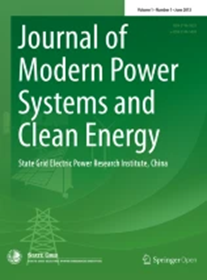Deterministic and Robust Volt-var Control Methods of Power System Based on Convex Deep Learning
IF 5.7
1区 工程技术
Q1 ENGINEERING, ELECTRICAL & ELECTRONIC
Journal of Modern Power Systems and Clean Energy
Pub Date : 2023-10-13
DOI:10.35833/MPCE.2023.000057
引用次数: 0
Abstract
Volt-var control (VVC) is essentially a non-convex optimization problem due to the non-convexity of power flow (PF) constraints, resulting in the difficulty in obtaining the optimum without convexity conversion. The existing second-order cone method for the convexity conversion often leads to a sharp increase in PF constraints and optimization variables, which in turn increases the optimization difficulty or even leads to optimization failure. This paper first proposes a deterministic VVC method based on convex deep learning power flow (DLPF). This method uses the input convex neural network (ICNN) to establish a single convex mapping between state parameters and node voltage to complete the convexity conversion while the optimization variables only correspond to reactive power equipment, which can ensure the global optimum with extremely fast computation speed. To cope with the impact brought by the uncertainty of distributed energy and omit the additional worst scenario search of traditional robust VVC, this paper proposes robust VVC method based on convex deep learning interval power flow (DLIPF), which continues to adopt ICNN to establish another convex mapping between state parameters and node voltage interval. Combining DLIPF with DLPF, this method decreases the modeling and optimization difficulty of robust VVC significantly. Test results on 30-bus, 118-bus, and 200-bus systems prove the correctness and rapidity of the proposed methods.基于凸深度学习的电力系统确定性和鲁棒性伏变控制方法
由于功率流(PF)约束的非凸性,电压-变压控制(VVC)本质上是一个非凸优化问题,导致在不进行凸性转换的情况下难以获得最优值。现有的二阶圆锥法进行凸性转换往往会导致 PF 约束和优化变量急剧增加,进而增加优化难度,甚至导致优化失败。本文首先提出了一种基于凸深度学习功率流(DLPF)的确定性 VVC 方法。该方法利用输入凸神经网络(ICNN)在状态参数与节点电压之间建立单一凸映射关系,完成凸性转换,而优化变量仅对应无功设备,能以极快的计算速度保证全局最优。为应对分布式能源不确定性带来的影响,省去传统鲁棒 VVC 的额外最坏情况搜索,本文提出了基于凸深度学习间隔功率流(DLIPF)的鲁棒 VVC 方法,继续采用 ICNN 在状态参数和节点电压间隔之间建立另一个凸映射。该方法将 DLIPF 与 DLPF 相结合,大大降低了鲁棒 VVC 的建模和优化难度。30 总线、118 总线和 200 总线系统的测试结果证明了所提方法的正确性和快速性。
本文章由计算机程序翻译,如有差异,请以英文原文为准。
求助全文
约1分钟内获得全文
求助全文
来源期刊

Journal of Modern Power Systems and Clean Energy
ENGINEERING, ELECTRICAL & ELECTRONIC-
CiteScore
12.30
自引率
14.30%
发文量
97
审稿时长
13 weeks
期刊介绍:
Journal of Modern Power Systems and Clean Energy (MPCE), commencing from June, 2013, is a newly established, peer-reviewed and quarterly published journal in English. It is the first international power engineering journal originated in mainland China. MPCE publishes original papers, short letters and review articles in the field of modern power systems with focus on smart grid technology and renewable energy integration, etc.
 求助内容:
求助内容: 应助结果提醒方式:
应助结果提醒方式:


